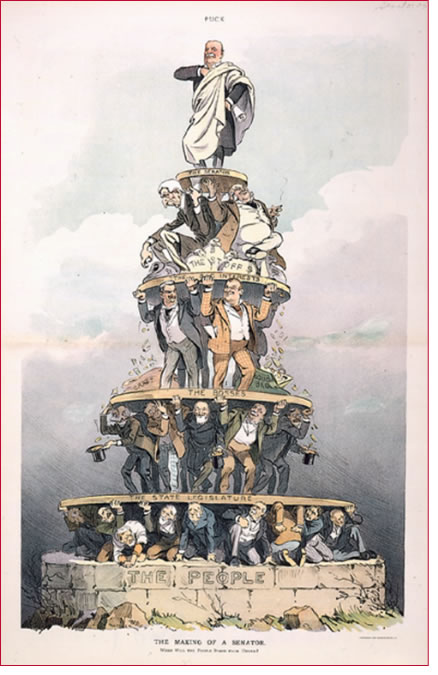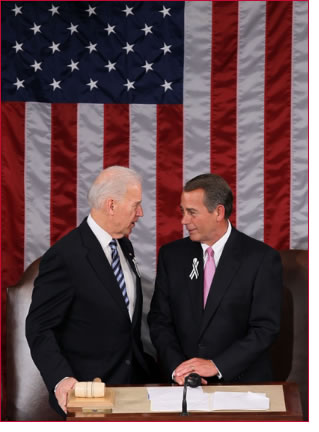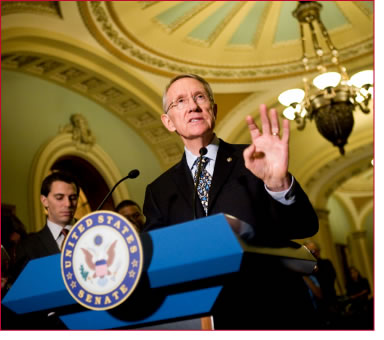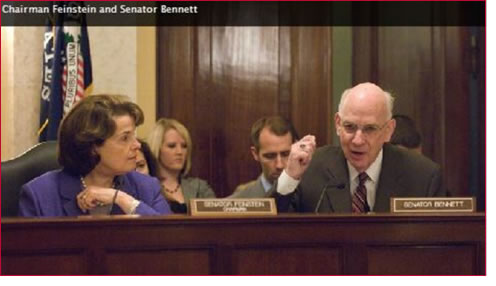The Senate
In the last lesson, you learned the House of Representatives is considered the chamber of Congress that is closer to the people. Yet, it is the Senate that is often referred to as the "upper house" in Congress. What does that suggest to you about the power and prestige of Senators compared to Representatives in the House?
In this lesson you will learn the rules of operations, the roles of the leaders, and the structure of committees within the Senate and compare them to those of the House of Representatives.
Explore senate.gov.
"The Upper House"
Each member of Congress is elected to represent the interests of their constituents. However, Senators represent entire states while Representatives represent an apportioned congressional district of a state. Senators serve six-year terms while Representatives serve two-year terms. The Senate consists of 100 senators (two from each state). There are 435 Representatives in Congress and each state has at least one Representative. Senators are often more nationally known due to their smaller number. These differences are among some of the reasons the Senate has the reputation of being the more powerful chamber or the upper house in Congress.

Qualifications of Senators
Because the framers intended for Senators to be knowledgeable politicians, the qualifications to be a Senator are more rigorous than those for Representatives. Senators must be at least 30 years old (25 years old in the House), citizens of the United States for at least nine years (7 years in the House), and residents of the state from which they are elected.
In addition, Senators are typically older and wealthier than House members. The Senate has been called the “millionaires club” because senators are wealthier than typical voters.

Illustration shows Nelson W. Aldrich standing at the top of a human pyramid on a platform labeled "The Senator", on the next level down John D. Rockefeller and a bloated man, typically identified with trusts, are sitting on bags of money on a platform labeled "The Big Interests", below them are men with bags labeled "Graft" and "Dough Bag", standing on a platform labeled "The Bosses", beneath them comes a larger group of men standing on a platform labeled "The State Legislature", and finally at the bottom is a group on a platform labeled "The People, who are being crushed by the weight of those above them.
Senate Elections
Members of the House of Representatives are directly elected by the popular vote of their constituents. However, the Constitution originally called for Senate members to be elected by state legislatures to prevent senators from facing too much pressure from public elections. In 1913 the Seventeenth Amendment was added to the Constitution which called for the direct election of senators by the voters.
Senators face elections every six years in order to focus on serving the interest of the nation as a whole rather than constantly worrying about pleasing constituents in re-election campaigns every two years like their colleagues in the House.

The image is a political cartoon. With the 1924 Presidential and congressional elections only two weeks away, politicians of all parties began to promise lower taxes to woo voters. In this cartoon, “Mr. Tax Payer” revels in all the attention as the Republican elephant, the Democratic donkey, and the Progressive goat try to outdo each other.
Leadership in the Senate
Though the Senate itself seems to be more powerful than the House, the Speaker and other leaders in the House of Representatives are generally more powerful than the leaders in the Senate.
The Vice President of the United States serves as the president of the Senate. The president of the Senate is a formal position with very little power except when there is a tie vote. In which case it is the Vice President's job to break the tie. Otherwise, the president of the Senate, or Vice President of the U.S., does not engage in debate or voting in the Senate.
If the Vice President is absent as president of the Senate, the president pro tempore presides over the Senate. Traditionally the role goes to the majority party senator who has served the longest in the Senate. The president pro tempore is third in line to succeed the President.

Senator Joe Biden, the president pro tempore of the Senate, shakes hands with Representative John Boehner, the Speaker of the House.
Senate Majority Leader
The Senate has leaders, like the House of Representatives, to direct the agenda and work of the majority and minority parties. The Senate majority leader is the most powerful member of the Senate. Like the majority leader in the House, the Senate majority leader is elected by members of the majority party during the party caucus at the beginning of each term. Also like the House, the Senate majority leader is the party spokesperson and sets the agenda for the majority party.
The Senate majority leader is well-known nationally as a major political figure. He or she works with party members to secure committee assignments in return for their cooperation.

Senate majority leader Harry Reid (2014).
Other Leaders in the House
Similar to the House, the Senate has several other leaders from both parties. In addition to the majority leader, there is a Senate minority leader who is the main spokesperson for the minority party.
Both parties elect a whip to "encourage" members of their party to support the party’s position and to vote with the party leaders. Like the majority and minority whips in the House, it is the job of the whips in the Senate to gather information about the votes of all members of the party and keep them from crossing the aisle.

Senate Committees
Similar to the House of Representatives, the real work in the Senate of reviewing and refining bills to become laws takes place in committees. There are several types of committees in the Senate that are similar to those in the House. In 2014, Senate committees included 20 committees (16 permanent standing committees and four temporary select or special committees), sixty-eight subcommittees, and four joint committees with the House.
Committees are headed by a chair who controls the business of the committee. The majority party chooses the chair based on seniority rule. Committee assignments are done by each party according to requests that are usually based on each senator’s interests and constituent needs. Each party distributes its members among the subcommittees within the committees. There is a limit placed on the number and types of committees that senators may serve on and chair.
Committee Power Unique to the Senate
The Senate has some powers that are unique to the Senate chamber only. The Senate provides advice and consent on certain presidential nominees. For example, the full Senate typically follows the recommendation of the Senate Judiciary Committee whose job it is to examine candidates nominated to be federal judges.
In addition, the Constitution requires a two-thirds majority vote by the Senate for a treaty to become law. If the chair of the Senate Foreign Relations Committee does not support a treaty, it has very little chance of passing the full Senate.
Senate Rules
The Senate Committee on Rules and Administration, like its House counterpart, is one of the oldest committees and is responsible for preparing a system of rules for conducting business in the Senate.
Unlike the House, the Senate has few limits placed on debate. Because of this, the Senate allows members to filibuster. A filibuster is a unique practice used by the minority party designed to prevent a vote on a measure that is likely to pass. It is basically a stall tactic in which the opponents of a measure take the floor and refuse to stop talking until the majority party is forced to move on to other business. Read Rules of the Senate.

Chairman Diane Feinstein and Senator Bennett of the Senate Committee on Rules.
Because there have been some historic filibusters in the Senate, the Senate passed a cloture rule in 1917 that allows for a two-thirds vote to enforce cloture or an end to debate. The rule was changed to 60 votes to achieve cloture in 1975. In 2013, Senator Rand Paul of Kentucky engaged in 13-hour hour filibuster on the Senate floor about the danger of drone strikes to U.S. citizens on American soil. The filibuster successfully pushed a potential vote to confirm President Barack Obama’s nominee to run the CIA off the day’s Senate agenda. Click on the picture below to learn more about Paul's action.

Review and Compare
Throughout this unit you have been introduced to the constitutional provisions of the legislative branch of the government of the United States. We have discovered similarities and differences in the rules of operations and the hierarchies of leadership within the House of Representatives and the Senate. We have identified several different types of committees in both chambers of Congress and just how important the work is in each. Watch the videos below to review and compare before completing the tasks at the end of this lesson.
Read House of Representatives vs. Senate.